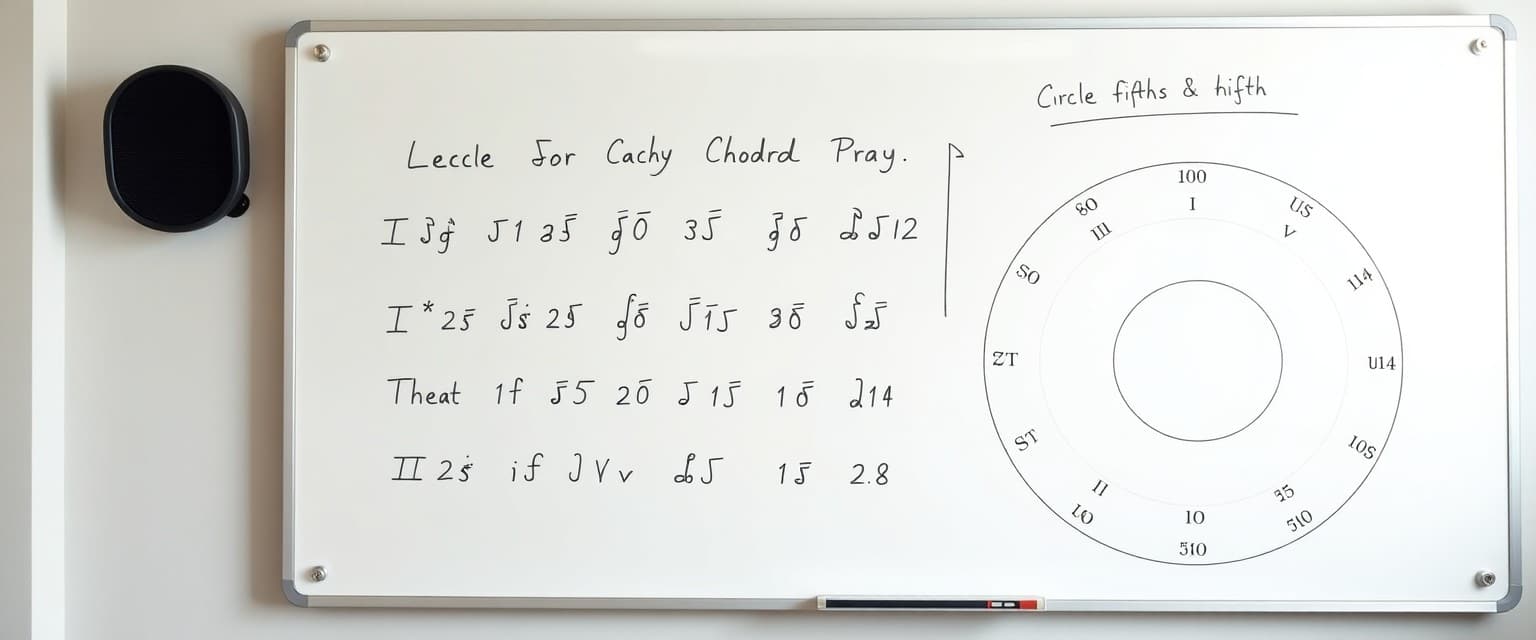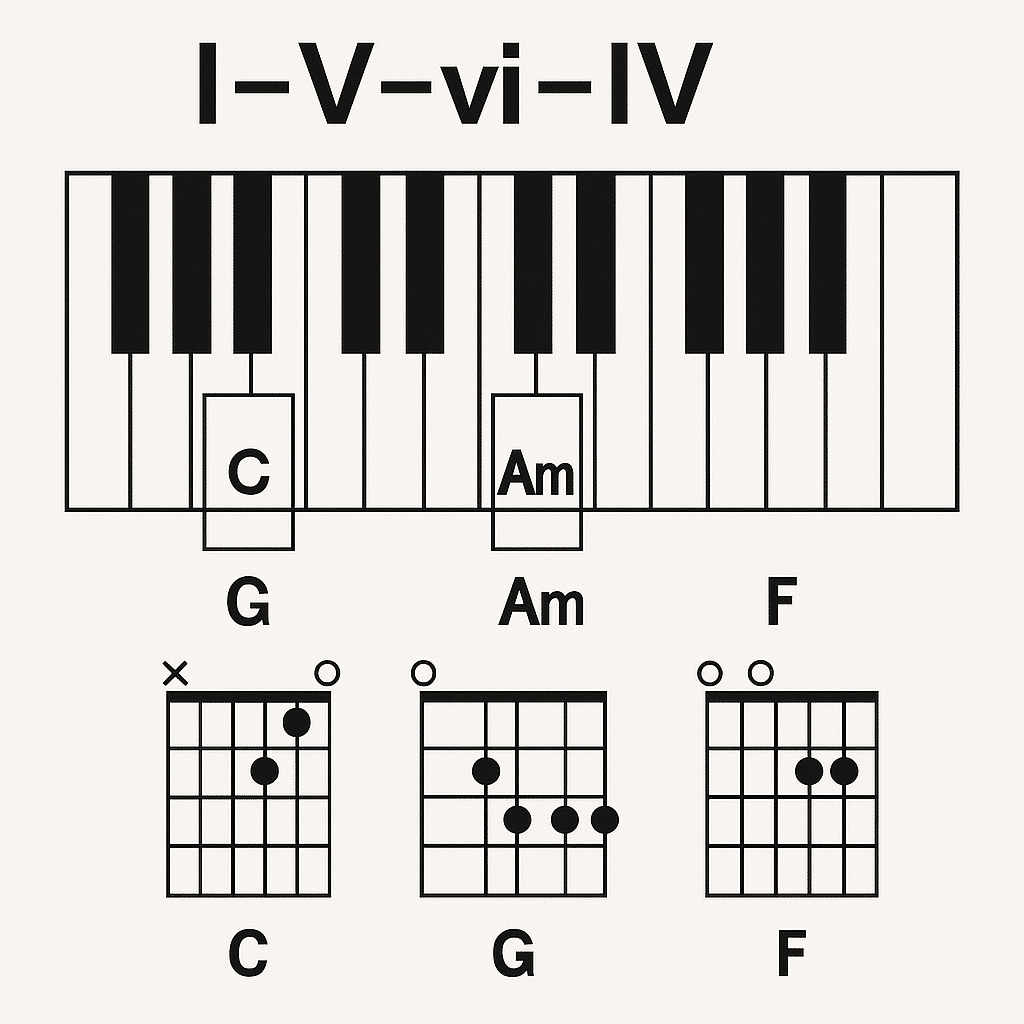Creating catchy chord progressions is essential for any songwriter looking to uplift their music and resonate with listeners. By utilizing common chord progressions such as the popular i-v-vi-iv or exploring the key of C, you can craft melodies that evoke strong emotions. In the major key, using major chords and their inversions can add a cheerful feel to your compositions.
For instance, a C major progression can transition smoothly to a D minor or A minorchord, showcasing the relationship between major and minor chords. These chord progressions often rely on diatonic harmony, which incorporates chords built from the major scale. When you create rhythmic patterns with these chords, you’re setting the stage for an engaging musical experience.
One popular approach is to include the iii chord and iv chord, which can help in creating a sense of anticipation before returning back to the tonic. This technique is frequently used in pop music and can be heard in many hit songs from the 50s to today. Additionally, experimenting with strumming patterns and incorporating a bass line can enhance the overall sound and depth of your pop chord progressions.
For those looking to improvise, using a C Mixolydian scale can provide a fresh perspective while still adhering to the principles of chord progressions. By mixing major to minor transitions, you can create a more melodic and feel-good atmosphere in your music. Whether you’re writing for soundtracks or crafting a new jazz music piece, understanding these catchy chord progressions will help you develop compelling and memorable songs that stick in the listener’s head.
What Makes a Chord Progression Catchy?
A chord progression defines the emotion and rhythm of a song. Catchy chord progressions use common chords like C, G, Am, and F in creative ways to create melodies that resonate with the listener. A good progression balances predictability with variation — a hallmark of every great songwriter.
The secret lies in harmony and diatonic structure — blending major and minor chords, cadences, and rhythmic accents that give your song life. Popular examples include:
- I–V–vi–IV (C–G–Am–F): universal and uplifting, heard in hundreds of hit songs
- vi–IV–I–V (Am–F–C–G): emotional and flowing
- ii–V–I (Dm–G–C): essential in jazz progressions
- I–IV–V (C–F–G): timeless and simple
- I–iii–IV–V (C–Em–F–G): cheerful and feel-good

These progressions appear across genres — from pop music and rock music to folk music — because they follow Roman numeral analysis patterns that sound familiar and emotionally satisfying.
Understanding Chords, Keys, and Harmonic Flow
Every chord progression starts with a key and a scale. In C major, you have the following chords:
| Degree | Chord | Type | Function |
|---|---|---|---|
| I | C | Major | Tonic (root chord) |
| ii | Dm | Minor | Subdominant |
| iii | Em | Minor | Mediant |
| IV | F | Major | Subdominant |
| V | G | Major | Dominant |
| vi | Am | Minor | Relative minor |
| vii° | Bdim | Diminished | Leading tone |
This simple structure forms the basis of most common chord progressions. You can extend it using modal interchange, borrow chords from Mixolydian or Dorian modes, or substitute a dominant 7th for expressive color.
Why the I–V–vi–IV Progression Works So Well
The I–V–vi–IV progression (C–G–Am–F) is the most iconic pop chord progression. It moves naturally through the circle of fifths and creates a smooth cadence that feels both familiar and fresh.
- I (C major): Establishes tonality and emotion.
- V (G major): Builds anticipation.
- vi (A minor): Adds depth and melancholy.
- IV (F major): Provides resolution and warmth.

These chords demonstrate how improvisation and inversion can change the emotional tone. Try rearranging them or adding a sus2 or Bm7 to enhance complexity.
How to Create Your Own Catchy Chord Progressions
- Start in C major or A minor. These keys are friendly for both beginners and experienced composers.
- Use rhythmic variation. Changing the bass line or timing of your triads can make simple progressions feel unique.
- Build cadences intentionally. Use a V–I cadence or ii–V–I to strengthen harmonic flow.
- Borrow chords creatively. Pull from Mixolydian or Lydian to introduce surprise and color.
- Experiment with inversions and extensions. Try ii chord, V chord, or vi chord shapes for variation.
Emotional Impact: Major, Minor, and Suspended Chords
The emotional quality of a chord progression comes from how you mix major chords, minor chords, and suspended chords. For example:
- Major chords (C, F, G): bright, confident, and uplifting
- Minor chords (Am, Dm, Em): nostalgic, reflective
- Dominant 7th chords (G7): add tension before resolution
- Suspended chords (sus2, sus4): create suspense or anticipation

This balance between major and minor chords shapes your song’s emotion. Combined with melody, it can evoke powerful feelings and keep listeners engaged.
Pro Songwriting Tip
Every great songwriter uses chord progressions to tell a story. Record a simple I–V–vi–IV loop, hum a melody, and vary your rhythm. You’ll notice how phrasing, rhythmic timing, and subtle harmonic shifts can elevate the song instantly.
For even more dimension:
- Use improvisation to explore different keys.
- Try modal changes with Mixolydian or Dorian.
- Experiment with roman numerals to analyze new ideas.
- Incorporate the circle of fifths to improve harmonic transitions.
Frequently Asked Questions About Catchy Chord Progressions
What makes a chord progression catchy?
A chord progression becomes catchy when it combines familiar harmonic movement with subtle surprises. Progressions like I–V–vi–IV or ii–V–I use predictable tonal flow, while rhythmic variations, borrowed chords, or changes in melody make them stand out and resonate emotionally with the listener.
What are the 4 golden chords?
The 4 golden chords are I–V–vi–IV. In the key of C major, that’s C–G–Am–F. This progression is the foundation of countless hit songs because it feels natural, balanced, and emotionally satisfying across pop, rock, and folk music genres.
How do I start writing my own chord progressions?
Begin with a simple key like C major or A minor. Choose 3–4 chords (for example, C–Am–F–G) and experiment with different rhythms and melodies. Try adding a V–I cadence or a borrowed chord from a related mode (like Mixolydian) to make the progression unique.
What is modal interchange?
Modal interchange means borrowing chords from parallel modes of the same key (for example, using F major from C Mixolydian while in C major). It’s a common songwriting trick to add color, tension, or unexpected emotion without changing the song’s tonal center.
Why is the I–V–vi–IV progression so popular?
This progression, used in hits by The Beatles, U2, and Ed Sheeran, moves smoothly through the circle of fifths and creates a pleasing balance of tension and resolution. Its cadence structure naturally supports memorable melodies that stick in your head.
What’s the difference between major and minor chords?
Major chords (like C or F) sound bright and uplifting, while minor chords (like Am or Dm) convey sadness or introspection. Mixing major and minor chords within one progression adds contrast and emotional depth to your songwriting.
What is a cadence in music?
A cadence is the musical punctuation at the end of a phrase or section — a point of resolution. The most common is the V–I cadence (for example, G to C), which gives a sense of completion and closure.
Common Chord Progressions to Inspire You
| Progression | Key | Mood | Notes |
|---|---|---|---|
| I–IV–V | C major | Uplifting | Perfect for beginners |
| ii–V–I | C major | Jazzy | Uses ii chord and cadence resolution |
| vi–IV–I–V | A minor | Emotional | Strong in ballads |
| I–V–vi–IV | C major | Universal | Used in pop chord progressions |
| i–III–VII–VI | A minor | Dramatic | Great for soundtracks |
Final Thoughts
The art of writing catchy chord progressions lies in mastering harmony, cadence, and emotion. Start with common chord progressions like I–V–vi–IV, then expand with diatonic and modal interchange ideas. Use inversion, extension, and improvisation to make your music truly stand out.
Catchy doesn’t mean complex — it means memorable. Combine melody, rhythm, and chords that resonate emotionally, and your listeners will remember your music long after the final note.
